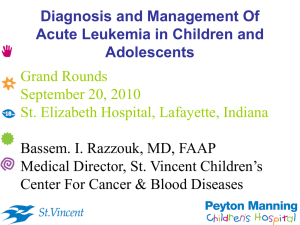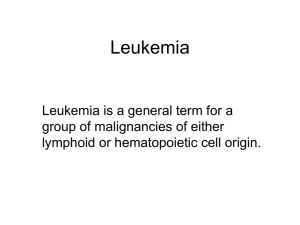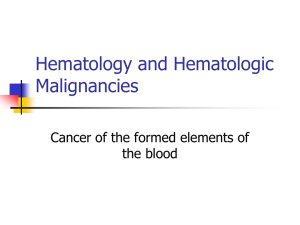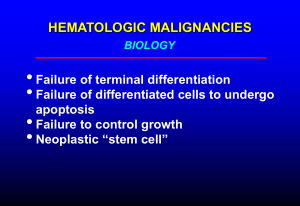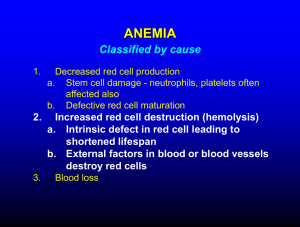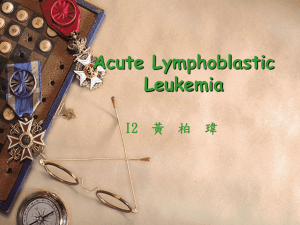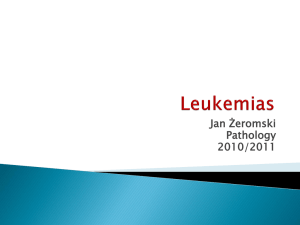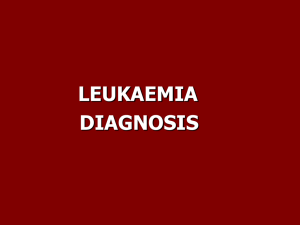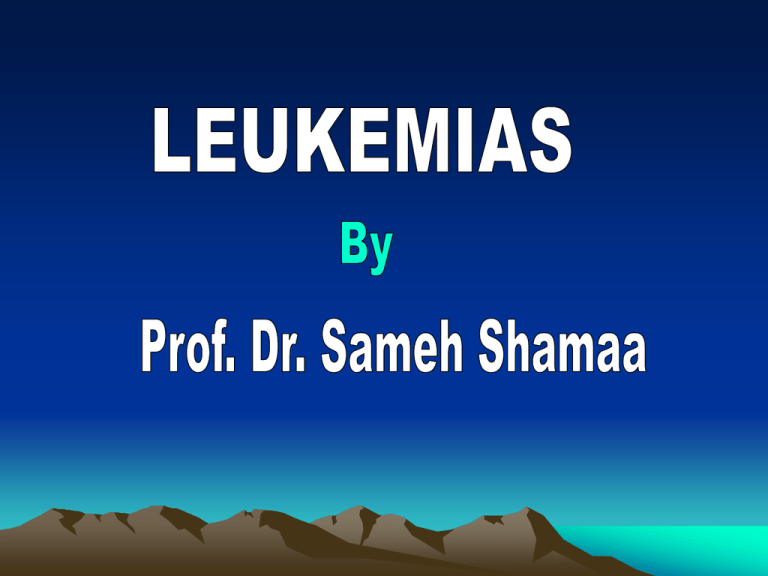
Conditions characterised by abnormal
proliferation of leucopoietic tissue and
appearance of immature forms of white
cells in the peripheral blood.
Acute Leukemias
Results from proliferation of young forms of
leucocytes at a stage when they do not enter the
circulation as readily as they do when more mature.
Classification:
* acute lymphoblastic L.
-----> more common
* acute myeloblastic L.
* acute monocytic L.
ACUTE LEUKEMIAS
Def:
Heterogenous group of neoplastic discases
characterized. by proliferation of atypical elements
which originates from the stem cells of the
hematopoietic system.
the uncontrolled and progressive proliferation
of these cells lead to:- Replacement of normal marrow
- Invasion of peripheral blood
-Infiltration of various organs and tissues
Relative frequency :-
Type
Children (≤ 14 years)
Adults >14 years
%
%
Lymphoblastic
65-80
10-25
Myeloblastic
6-25
20
Myelomonocytic
2-6
20
Monocytic
2-6
1-10
Promyelocytic
1-2
10
Erythroid
0-1
3
Megakaryocytic
0-1
1
Etiology:Unknown, some factors seem to be implicated: A- Environmental factors:•Ionizing radiation; mainly AML but ALL less important
•Chemical substances; prolonged exposure to certain
substances (benzene, phenylbutazone, chloramphenicol,
anticancer drugs, alkylating agents, natulan) --->
incidence of leukemia mainly AML
Onset often preceeded by a state of bone marrow
hypoplasia, peripheral pancytopenia
(preleukemic syndrome).
B-Genetic:May act by facilitating envirnomental factors.
C- Viruses:Based on experiments with laboratory animal, has
never proved humans. Typical products of viruses
have been identified in some adult patients.
With T.ALL:HTLV (human T cell lymphotrophic virus) in T cell
ALL and hairy cell leuk.
D- Immunological Factors: Patient with acquired or congenital immune
deficiency syndrome or subjected to prolonged
immunosuppresive treatment has ↑ incidence of
leukemia.
Differential Diagnosis :
------------------------------------------D.D. between various forms of acute
leukemia
is
mainly
on
cytomorphologic,
cytochemical criteria rather than on clinical data,
which are often superimposable.
age: may accur at any age but in general:
-A.L.L --- > the peak incidence in 1st 6 years of
life. Uncommon after age of 20
-A.M.L.--- >more commonly at slightly older age
groups centering around the teen-age or adolescent
period
-A. Monocytic leuk. --->no specific age group.
Clinical Picture
1- Fever: moderate or high grade, usually irregular and shoots up when 2ry
infection occur
2-rapidly developing marked asthenia.
3- rapidly developing severe anaemia ---> marked pallor.
4-severe bone ache allover the body
5-Severe sore throat
6- bleeding tendency from --->----- > gums.
-------> skin
--------> orifices
--------->int. organs.
7-tender bones
8- joint pain (bleeding & infiltration)
9-L.N. enlargement in --->------> A.L.L.
---->A.M.L.
---->A. Monocytic L.
10-spleen & Liver enlargement.
11-Chloromas :- more in A.M.L. (subperiosteal tumor like masses)
12-C.N.S --->Focal Hge or infection of nerves or meningies.
Blood Picture :A.L.L :
* R.B.Cs ---> severe form of normocytic
ncrmochromic anemia occurs early.
* W.B.cs ---> ( ) 10,000 --- 100,000 Or more but
40% are leukopenic
- Lymphocytes are likely to be the predominant cells.
- The diagnosis is established by detecting lymphoblastes in
the peripheral smear.
(N.B. Lymphoblastes :
large cells with clear cytoplasm,
prominant nucleus, definite nucleole.
Diff. From mycloblastes :- absent specific granules of
cytoplasm, -ve peroxidase stain
-PAS +ve - Sudan Black -ve or weekly +ve
* platelets : usually < 100.000
may be completetly absent.
2- Myeloblastic Leuk
- W.B.Cs. count as A.L.L.
- Leukopenia is as likely to occur as A.L.L
- The cells are peroxidase +ve, PAS –ve, Sudan
black +ve , acid phosphatase +ve
- In 10 - 20% :Auer bodies are present rod like structures.
in cytoplasm of------------> myeloblast
-------------> monoblast
3- Monocytic Leukemia:
- monoblast in the peripheral blood. Stain PAS ve, Sudan B +ve, Peroxidase -ve acid phosphatase +ve
Bone marrow aspiration:
Massive proliferation of blast cells even when leukopenia
exist.
* A.L.L-----> lymphoblast
* A.M.L---->myeloblast
*A. monocytic----> monoblasts and monocytes.
*Radiology :-Sketetat involvement in almost all children and 50% of
dults.
* diffuse osteoprosis
* periosteal elevation
* osteolytic lesions
* radiolucent metaphyseal bands.
Diff- diagnosis :The combination of * anemia
* thrombocytopenia
* bone marrow prolif. è
primitive white cells is found only in leukemia.
(1)From other causes of sore throat + Fever as:-
* vincent angina.
*diphtheria.
*infectious, mononucleosis.
*aplastic anemia.
*agranulocytosis.
(2) from other causes of parpura :* I.T.P
*Aplastic anemia.
(3) Lymphadenopathy + splenomegally:* infective mononucleosis
*H.D. .N.H.L. (by blood picture)..
(4)Lymphocytosis :in :.
* whooping caugh
*infective lyrmphocytosis.
(white cells mature, R.B.Cs and platelets are normal).
(5)Rheumtic Fever
Name
Description
ICD-O
•Includes: AML with translocations
between chromosome 8 and 21
[t(8;21)]
(ICD-O
9896/3);
RUNX1/RUNX1T1
•AML with inversions in chromosome
16
[inv(16)]
(ICD-O
9871/3);
AML with characteristic genetic CBFB/MYH11
Multiple
abnormalities
•AML with translocations between
chromosome 15 and 17 [t(15;17)]
(ICD-O 9866/3); RARA;PML
Patients with AML in this category
generally have a high rate of
remission and a better prognosis
compared to other types of AML.
This category includes patients who
have had a prior myelodysplastic
syndrome
(MDS)
or
myeloproliferative disease (MPD) that
AML with multilineage dysplasia
M9895/3
transforms into AML. This category of
AML occurs most often in elderly
patients and often has a worse
prognosis.
This category includes patients who
have had prior chemotherapy and/or
radiation and subsequently develop
AML and MDS, therapy-related
AML or MDS. These leukemias may M9920/3
be
characterized
by
specific
chromosomal abnormalities, and
often carry a worse prognosis.
Includes subtypes of AML that do not
AML not otherwise categorized
M9861/3
fall into the above categories.
aaa
Name
Cytogenetics
M0
minimally differentiated acute myeloblastic leukemia
M1
acute myeloblastic leukemia, without maturation
M2
acute myeloblastic leukemia, with granulocytic
maturation
t(8;21)(q22;q22), t(6;9)
M3
promyelocytic, or acute promyelocytic leukemia (APL)
t(15;17)
M4
acute myelomonocytic leukemia
inv(16)(p13q22),
del(16q)
M4eo
myelomonocytic together with bone marrow eosinophilia inv(16), t(16;16)
M5
acute monoblastic leukemia (M5a) or acute monocytic
leukemia (M5b)
M6
acute erythroid leukemias, including erythroleukemia
(M6a) and very rare pure erythroid leukemia (M6b)
M7
M8
acute megakaryoblastic leukemia
acute basophilic leukemia
del (11q), t(9;11),
t(11;19)
t(1;22)
The FAB classificationSubtyping of the various forms of
ALL used to be done according to the French-AmericanBritish (FAB) classification,[18] which was used for all
acute leukemias (including acute myelogenous leukemia,
AML).
ALL-L1: small uniform cells
ALL-L2: large varied cells
ALL-L3: large varied cells with vacuoles (bubble-like
features)
Each subtype is then further classified by determining the
surface markers of the abnormal lymphocytes, called
immunophenotyping. There are 2 main immunologic
types: pre-B cell and pre-T cell. The mature B-cell ALL
(L3) is now classified as Burkitt's lymphoma/leukemia.
Subtyping helps determine the prognosis and most
appropriate treatment in treating ALL
WHO proposed classification of acute
lymphoblastic leukemia
The recent WHO International panel on ALL
recommends that the FAB classification be
abandoned, since the morphological
classification has no clinical or prognostic
relevance. It instead advocates the use of the
immunophenotypic classification mentioned
below.
1- Acute lymphoblastic leukemia/lymphoma
Synonyms:Former Fab L1/L2
i. Precursor B acute lymphoblastic
leukemia/lymphoma. Cytogenetic subtypes:[19]
t(12;21)(p12,q22) TEL/AML-1
t(1;19)(q23;p13) PBX/E2A
t(9;22)(q34;q11) ABL/BCR
T(V,11)(V;q23) V/MLL
ii. Precursor T acute lymphoblastic
leukemia/lymphoma
2- Burkitt's leukemia/lymphoma
Synonyms:Former FAB L3
3- Biphenotypic acute leukemia
Treatment:Combination chemotherapy
in order to :*
*
*
*
obtain synergestic action
minimize side effects.
attacks leukemic cells in different phases of mitosis.
delay the onset of resistance of the malignant cells.
Acute L. Leuk. effective drugs are
1- vincristine-----> arrest cell mitosis
2- predinsone ----> Lyrmpholysis
3-6.M.P. ----> inhibit DNA synthesis.
4-Methotrexate ----> inhibit RNA and protein
synthesis
5-Doxorubich (adriamycin)----> inhibit DNA
synthesis
6-L- asparaginase
Phase
Description
Agents
The aim of
remission
induction is to
rapidly kill most
tumor cells and
Combination of
get the patient into
Prednisolone or
remission. This is
dexamethasone
defined as the
(in children),
presence of less
Remission
vincristine,
than 5% leukemic
induction
asparaginase, and
blasts in the bone
daunorubicin
marrow, normal
(used in Adult
blood cells and
ALL) is used to
absence of tumor
induce remission
cells from blood,
and absence of
other signs and
symptoms of the
disease.
Intensification Intensification uses high doses of intravenous multidrug
chemotherapy to further reduce tumor burden. Since ALL cells sometimes penetrate
the Central Nervous System (CNS), most protocols include delivery of
chemotherapy into the CNS fluid (termed intrathecal chemotherapy). Some centers
deliver the drug through Ommaya reservoir (a device surgically placed under the
scalp and used to deliver drugs to the CNS fluid and to extract CNS fluid for various
tests). Other centers would perform multiple lumbar punctures as needed for testing
and treatment delivery. Typical intensification protocols use vincristine,
cyclophosphamide, cytarabine, daunorubicin, etoposide, thioguanine or
mercaptopurine given as blocks in different combinations. For CNS protection,
intrathecal methotrexate or cytarabine is usually used combined with or without
cranio-spinal irradiation (the use of radiation therapy to the head and spine). Central
nervous system relapse is treated with intrathecal administration of hydrocortisone,
methotrexate, and cytarabine.
Maintenance therapy The aim of maintenance
therapy is to kill any residual cell that was not
killed by remission induction, and
intensification regimens. Although such cells
are few, they will cause relapse if not
eradicated. For this purpose, daily oral
mercaptopurine, once weekly oral
methotrexate, once monthly 5-day course of
intravenous vincristine and oral corticosteroids
are usually used. The length of maintenance
therapy is 3 years for boys, 2 years for girls and
adults.
These drugs must be used sequentially and in
combinations:-
a-Induction therapy:* To obtain apparent clinical & hematological remission
* 2 or 3 drugs used
- Vincristine 1.4 mg/m2 I.V. once weekly for 4 weeks...
- prednisone lmg/kg body weight P.O. daily
- L. asparaginase
or Adriamycin
b- Consolidation theraby:*to decrease total no. of residual malignant cells to
10G cells or less.
* e.g. Methotrexate : 15 mg/m2I.M. daily For 3 - 5
days..
followed by cystarabine 100 mg/ m2 I.V. twice
daily for 3-5 days.
c- C.N.S. prophylaxis
by
* cranial irradiation 1800 2400 R
* Intra thecal (l.T.) Methotrexate in
mg/ m2 for 5 injection. (twice weekly).
d- Prolonged maintenance :~
* 2-3 years
* Methotrexate 15 mg/ m2 once or twice weekly
I.M.
* 6 M.P 1-2.5 mg/kg daily P.O.
*Cyclophosphamide: 200mg/ m2 p.o. weekly.
Acute Non Lymphoblastic L.
-The
initial objectives is the induction of a CR. (reduction of
marrow blasts to less than 5%, increase in neutrophils in the
peripheral blood to l.5x 106 /L. or more and of platelets to
100x 106/L. or more.).
-Then consolidation therapy follows, for which identical
drugs are used (the aim is further reduction of leukemic
cells).
- Both in induction and consolidation, high dosage of drugs
are given to produce temporary marrow aplasia.
-After the marrow have recovered from consolidation
therapy, maintenance therapy is given at monthly intervals
usually for 2-3 years, aiming for a further stepwise
reduction of remaining leukemic cells without making the
marrow splastic
-The cornerstone of remission induction and consolidation
chemotherapy is a combination of cytosine-arabinoside and
daunorubicin resulting in 50% CR rates.
-Drugs used for maintenance: cytosine-arabinoside, 6thioguanine, cyclophosphamide and daunarubicin.
However the value of maintenance treatment is
marjinal.
complications :(1)Severe bone ache or massive C.N.S infiltration.
---- > Local irradiation
(2)C.N.S. involvement:
----> intrathecal Mtx. 12 mg I.T./3 days + cranial
irradiation
(3)Fever.
(4)Hge.
(6)Hyperuricemia
Prognosis
(1) A.L.L
----->C.R. ----> 90% of children.
----> 60% of adults.
----> Cure in 70% of children. and 35% of adults.
Allogenic bone marrow transplantation is the only form of
therapy for patients with drug -resistant disease
(2) A.N.L.L.----->C.R is up to 50%
- only about 25% remain disease free after 5 years and can expect to
be cured
However, bone marrow transplantation if preformed during First
remission can improve survival and it has been suggested to be
preformed in all patients younger than 50 years and who have available
HLA identical donor
Risk Category
Abnormality
5-year survival
Relapse rate
Favorable
t(8;21), t(15;17),
inv(16)
%70
%33
Normal, +8, +21,
+22, del(7q),
del(9q), Abnormal
Intermediate
11q23, all other
structural or
numerical changes
%48
%50
-5, -7, del(5q),
Abnormal 3q,
Complex
cytogenetics
%15
%78
Adverse
[edit] Prognosis
The survival rate has improved from zero four decades ago, to 20-75
percent currently, largely due to clinical trials and improvements in bone
marrow transplantation (BMT) and stem cell transplantation (SCT)
technology.
Five-year survival rates evaluate older, not current, treatments. New drugs,
and matching treatment to the genetic characteristics of the blast cells, may
improve those rates. The prognosis for ALL differs between individuals
depending on a variety of factors:
Sex: females tend to fare better than males.
Ethnicity: Caucasians are more likely to develop acute leukemia than
African-Americans, Asians and Hispanics and tend to have a better
prognosis than non-Caucasians.
Age at diagnosis: children between 1–10 years of age are most likely to
develop ALL and to be cured of it. Cases in older patients are more likely to
result from chromosomal abnormalities (e.g. the Philadelphia chromosome)
that make treatment more difficult and prognoses poorer.
White blood cell count at diagnosis of less than 50,000/µl
Cancer spread into the Central_nervous_system (brain or spinal cord) has
worse outcomes.
Morphological, immunological, and genetic subtypes
Patient's response to initial treatment
Genetic disorders such as Down's Syndrome
Cytogenetics, the study of characteristic large
changes in the chromosomes of cancer cells, is
an important predictor of outcome.[13]
Some cytogenetic subtypes have a worse
prognosis than others
Cytogenetic change
Risk category
Philadelphia chromosome
Poor prognosis
t(4;11)(q21;q23)
Poor prognosis
t(8;14)(q24.1;q32)
Poor prognosis
Complex karyotype (more
than four abnormalities)
Poor prognosis
Low hypodiploidy or near
triploidy
Poor prognosis
High hyperdiploidy
(specifically, trisomy 4, 10,
17)
Good prognosis
del(9p)
Good prognosis

